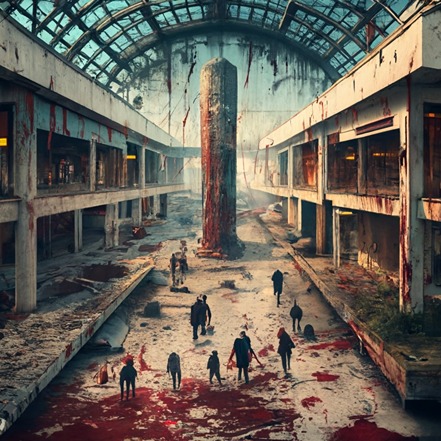The Case Of Abandoned Malls: Can Consumerism Kill Them?
From the point of view of many men, and I am among them, there is no doubt that visiting the mall can be one of the scariest experiences. Some of the reasons are the collection of stores that include items that are not always interesting, the rush of people reminiscent of a zombie attack, and the exorbitant prices that will kill your checking account. Visiting the mall is okay and maybe even fun, but it can go wrong. The good news is that the malls you know can be much friendlier and mostly less intimidating, than their empty counterparts. This is the moment to talk about “dead” shopping malls, a phenomenon that has unfortunately become very common worldwide in recent years.
In the realm of abandoned places, or a broader sense, scary places in the urban space, it’s hard to find more fascinating and creepy places than dead malls. Once bustling centers of commerce, these places have stood for years, almost without a living soul. Sights of disorder or destruction, which look like they came out of the latest zombie movie, create a sad, fascinating, and scary experience. So this is the moment to prepare your wallet (at least metaphorically), go through an abandoned ghost mall, and understand if there is still hope for the shopping world.

What Is A Dead Mall?
You know when you are in a specific entertainment place, which is quite empty of people at the moment, and you say a phrase like “this place is dead”?
This is precisely the picture of the dead malls, only more extreme. Think of a film like “Dawn of the Dead” by George A. Romero, the ultimate zombie mall movie, which shows a struggle for life and death against hordes of zombies in a shopping mall, an explicit criticism of capitalism and consumer culture in the 70s, when shopping malls gained their power. So it is true that, in reality, there are no zombies in malls, at least not yet, but some of them are abandoned and show the less beautiful sides of today’s shopping scene.
Dead malls, also known as “ghost malls” or even “zombie malls,” are abandoned shopping centers that no living soul passes through. You will be able to see in them – if you manage to get in, of course – everything we expect from such a place, such as dusty or broken shop windows, damaged furniture, objects placed in disarray, damages of time such as peeling paint, dust or corrosion, and above all a chilling silence, which is many times different From what was in these busy shopping centers in the past.
At this point, it is essential to note that there are abandoned malls that are indeed active in one way or another. We will not give a shopping center this sad nickname if it has two or three stores currently without tenants, with the famous sign of a brokerage office of some kind, because, after all, the turnover of businesses is an integral part of every shopping center. Dead malls, on the other hand, will be those in which a large part of the complex, most or even all, will be empty of people and usually of merchandise. Because even if some items are left in them, you can count on people who will find a use for them, legally or illegally.
Either way, the eerie atmosphere of abandoned malls can be disturbing. The combination of abandoned shops, dim corridors, and apocalyptic chaos, as happens in some cases, make the places scary. We can add unwanted populations that have taken over some centers, such as the homeless, drunk, or drugged. You don’t have to go far to understand the effect of fear. Sometimes, these changes attract the curious people drawn in advance to abandoned places, quite scary in this case, as part of the “Horror Tourism” now considered more in demand than ever. You can see this also in different kinds of zombie mall game, for the pc or even a print meant to be a board game.

How Many Dead Malls Are There?
The phenomenon of abandoned shopping malls is nothing new, although many argue that it has increased significantly in recent years for reasons we will explain immediately. According to the numbers, most common ghost malls are located in North America and China, with a vast population – but mostly countless online businesses and stores competing for their attention.
It’s hard to know exactly how many dead malls there are in the United States, for example, but the estimates are anything but encouraging. According to this site, during the 1980s there were about 2,500 malls in the United States. Today the number has dropped to only about 1,000-750, depending on who you ask and how you count them. The predictions say that in the next decade, the number of canines can be around at most about 250. You can find a list of dead malls online, including list of dead malls by state for example in this website, but we guess it’s not the full list.
To get you in the right (and creepy) mood, here’s a short video introducing some terrifying abandond malls:
What Could Kill Shopping Malls?
In a way that won’t surprise you, the reasons for the formation of dead malls are mainly related to one or another consumer aspect, sometimes at the country level or even changes on a global scale. The basic premise is that shopping malls are one of the clear manifestations of consumer behavior in a certain period, and one can understand why, in recent years, we are at a very complex point in time.
The first aspect, which most people will see positively, is related to the increase in online shopping. When you can buy almost anything online, in most cases at a price similar to or lower than that of physical stores, it is easy to assume that fewer people will visit the malls. Visiting shopping malls has associated costs, such as fuel and parking, which could be more fun to pay. What’s more, we live when the average person doesn’t have too much time, and online shopping can save him at least a few hours.
It is impossible to ignore the changes that have taken place in our world in recent years, which explains why the chances of forming an abandoned shopping mall are exceptionally high today. The COVID-19 epidemic accompanied us for years, starting at the beginning of 2020, and included strict social distancing guidelines and restrictions that resulted in the malls being unable to open for a specific time (mainly the original shopping centers). It was a severe and fatal blow to their businesses, and many could not recover. The significant price increases of recent years, partly in commodity prices or rental costs, have made the picture even more complex for businesses that have had to reduce activity, move to cheaper locations, or close completely.

Other reasons for the formation of an abandoned malls are:
Demographic changes – including a decrease in suburban populations and an increase in urban areas, which have turned into the fact that malls that were previously in more bustling places on the outskirts of cities Dealing with significant customer abandonment
Over-expansion – today’s economic world is more competitive than ever, and one expression is the competition between shopping malls. There are ample shopping centers, and some would say even too wide. According to some data, the number of malls in the United States grew between 1970 and 2015 at a rate roughly twice the rate of population growth, which caused a saturated and overly competitive market. This competition bites into the revenues of the businesses in particular and the shopping centers in general, certainly when there is at the same time the struggle against the Internet, which leads to the dying and sometimes even the “death” of the shopping center

Change in business patterns – many large businesses, which once attracted visitors to shopping malls, today prefer to open independent centers, with everything needed for a fun (and expensive) pastime of at least a few hours. The giant Max stores, for example, come to some extent at the expense of smaller businesses that operate in specific niches.
Lack of adaptation – the audience’s preferences today differ from the past. Shopping centers that did not adapt themselves or could upgrade over the years were left behind.
Reduction in consumer activity – today, when the cost of living in many parts of the world is rising at a faster rate than average salaries, spending time at the mall is seen as a luxury that not everyone can or wants to afford
Low accessibility: Somewhat surprisingly, and mostly disappointingly, getting to some malls is complex. From parking problems through inefficient public transportation and massive traffic jams on the way to and from the mall, not everyone wants to go through this “pleasure” every time.

Can Dead Malls Reborn? The Future Of Abandoned Malls
The more encouraging news is that the abandonment of a shopping mall does not have to be the end of the story, even if its destiny is usually a complex task, which is replaced by demolition and constructing a structure for other purposes. You can find pretty easily abandoned malls for sale, if you have the money, and it can be a good invasion.
In general, recalculating the route regarding the designation of an abandoned mall can put them back on the consumer map. Office centers, entertainment complexes, or business complexes with a different concept are some of the more common changes. They involve a complex financial investment, but in the optimistic scenario, they can “revive” the malls, even if in a different way. Today, there is a greater demand for open-air shopping centers, which is part of the trend change that has managed to keep certain malls alive.
Today we must think outside the box: How to provide the mall visitors with the experience they expect. Today, successful shopping centers appeal in advance to a broader population and offer more than just stores, so the boundaries between consumerism, recreation, and leisure are becoming blurred. You can find in malls today countless restaurants, cafes and food stalls, designated areas for children (from simple facilities or video games to Gymboree or extreme sports complexes), activities for the whole family that can turn into a horror movie (whoever visited the mall during a free and jam-packed show of first-rate children’s artists will agree) – and the list goes on. In the most optimistic scenario, a mall that manages to understand this and provides the audience with the added value they expect can come back to life.
So the next time you’re at the mall, while you’re carrying a lot of bags obanf products you might not use, looking for a reasonable restaurant that won’t cut you off on the price or an activity that will provide fun for the kids and peace of mind for you, try to take a look and see the positive sides of these shopping centers. Because if they keep dying like zombies in Romero’s movie, creating more and more abandoned malls, the consumer life of all of us could be more complex.






